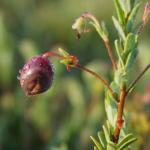Early rot has already been reported on Early Blacks and Stevens. This fruit rot disease is one of the first to be observed during the growing season. Infected fruit have brown-dark brown spots with concentric rings and as infection progresses, black, pimple-like structure (pycnidia) may be visible on the fruit surface.
Virus-like symptoms have also been reported on Stevens. Tobacco Streak Virus and Blueberry Shock Virus can cause severe scarring symptoms on fruit. Special testing is required to confirm both viruses, so if you are observing unusual fruit symptoms and fruit scars please contact Erika at (508) 295-2212 ext.18/19.
 Blossom 'blast', or heat injury to flowers, was observed in Crimson Queen. Heat injury in flowers and young tissues may occur with temperatures as low as 86F, especially in areas with poor vining or near water puddles. Heat injury and sunscald on fruit can be prevented by cooling the canopy with overhead irrigation. For more information, please call the Station and talk to Erika (x18) or Peter (x29).
Blossom 'blast', or heat injury to flowers, was observed in Crimson Queen. Heat injury in flowers and young tissues may occur with temperatures as low as 86F, especially in areas with poor vining or near water puddles. Heat injury and sunscald on fruit can be prevented by cooling the canopy with overhead irrigation. For more information, please call the Station and talk to Erika (x18) or Peter (x29).
You should be sampling fruit and inspecting for cranberry fruitworm eggs. We have been finding lots of hatched, dead and otherwise eggs, but you need to look to make sure you don't have a threshold number of unhatched viable eggs. Remember you can only do 9 oz/A of Altacor per season, which is usually 2 applications since most folks go with 4.5 oz/A. Delegate is good for later in the season as a "clean up" spray, if you can do it. For Spag, Altacor, Delegate, and Intrepid are your best choices. Altacor and Intrepid are preferred choices if you still have bees on your bog.
We have a 2ee recommendation for QuinStar: Application time can be reduced to less than 30 minutes if experience has shown that the existing chemigation equipment can distribute the product uniformly over the area to be treated. The label previously recommended injecting for 30-45 minutes. MDAR has approved the 24c for the use of Callisto as a concentrated spot application as well as using less adjuvant when chemigating the herbicide. You can use 1-4 pt/A instead of the 0.25% v:v, which usually means 1-2 gallons per acre. We should be getting copies of the supplemental label soon and will post it to our web site and distribute to ag suppliers.
We will be offering a workshop on how to use our new weed ID guide and do basic weed identification. It will be held on Tuesday August 4 9:30-11 AM in the library at the Station. Please let us know if you are coming (x10 or 21). The cost is $20 to attend and you get a copy of the guide.